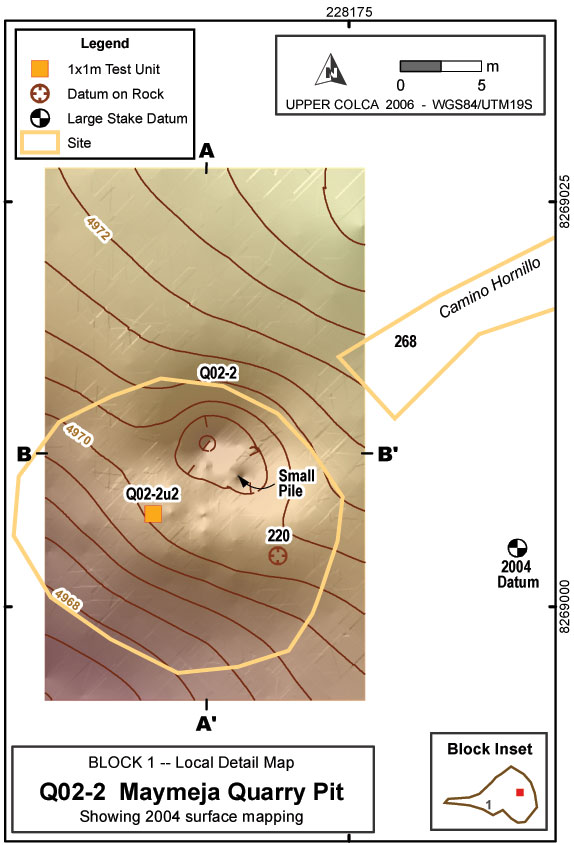7.4.1. Q02-2, Test Unit 2
The broader context of Q02-2 and a map of the quarry pit vicinity are shown in the Early Pastoralists section of Chapter 6 (see Figure 6-45). Few concentrations of cultural artifacts were found on the surface of the quarry pit that would have aided in selecting a location for the 1x1m test unit. There was a great quantity of fractured obsidian, but as will be described below, the test excavation showed that geologically fractured obsidian was the rule and culturally produced flakes were rare in this area. Lag gravels consisting of small, 1-5cm obsidian nodules were observed in a very light tephra-rich soil that formed the context of the quarry pit. The area had little evidence of cultural activity except the excavated pit itself, the associated debris pile, and the greater concentration of dozens of 5-15cm nodules in the bottom of the quarry pit.
Figure 7-4Map of quarry pit showing topographic surface acquired using a total station.
Figure 7-5. (a) Perspective view of quarry pit, (b) Perspective view bisected with an inferred natural slope.
The Q02-2 pit is a depression that measures approximately 4m by 5m, with a depth of 1.5m despite evidence that this pit, excavated into sandy soils, has collapsed margins and has been partially refilled over the years (Figure 7-4). If the area that deviates from the natural slope, including the accumulation pile downslope, is included the disturbed area grows to measure 10m by 12m. Oblong quarry pits ringed by semi-circular debris piles are described at obsidian sources in central Mexico by Healan (1997) and by Darras (1999: 80-84), although this quarry pit falls in the medium size range by Mexican standards.
Figure 7-6. The quarry [Q02-2] and workshop [A03-126] are 600m apart. In this image snow blankets most south-facing slopes but the quarry pit debris pile is visible protruding through the snow mantle.
The deepest part of the Maymeja quarry pit at Chivay tends to retain snow (see photo in Figure 6-45), and in the southern half of the quarry depression it was evident that more recent disturbance had occurred. A small mound of light, sandy soil and many small nodules of obsidian are labeled as "small pile" in Figure 7-4. This small mound measures 1m by 1.5m and is 30cm in height. This small pile appears to be the result of recent excavation work and perhaps resulted in the exposure of the 5-15cm nodules currently visible in the pit.




